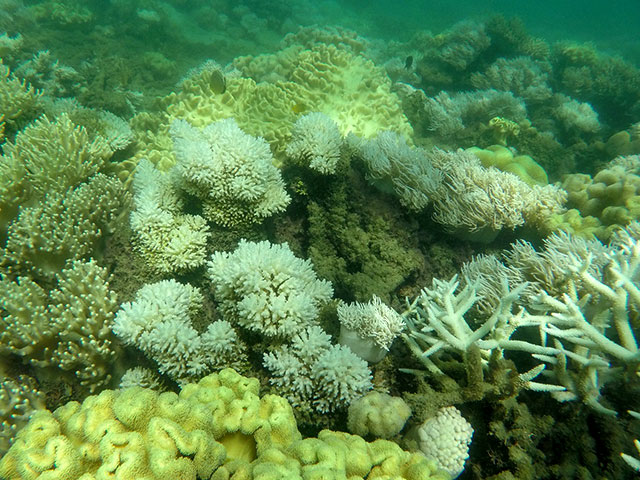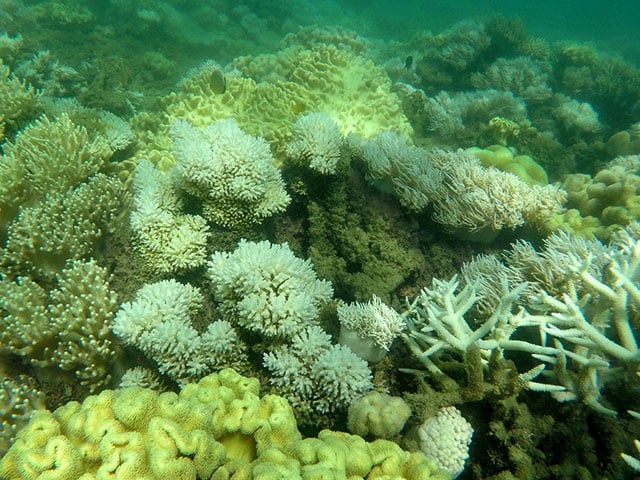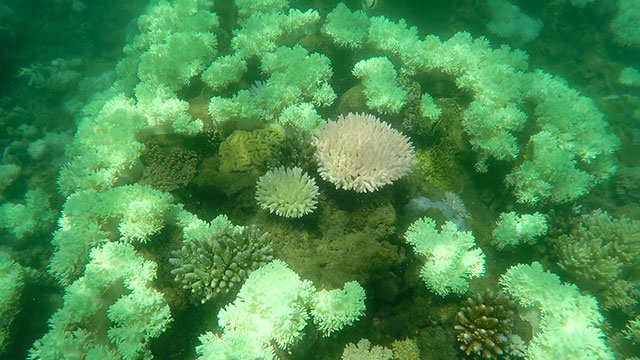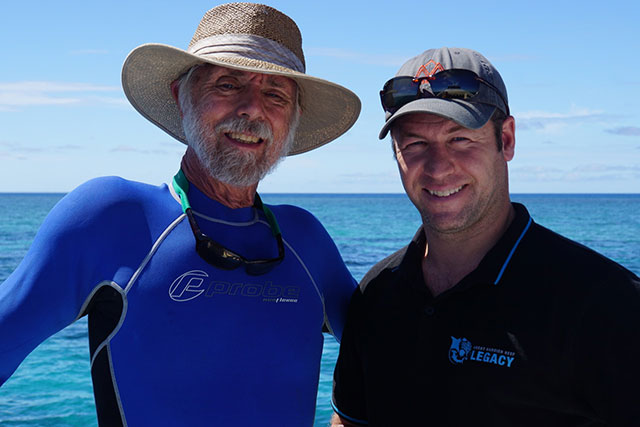
Part of the Series
Planet or Profit
 Coral off the northeast coast of Australia, which is undergoing a bleaching event. Approximately 95 percent of the coral in this area is bleached, signifying what could be another major coral bleaching event on Australia’s Great Barrier Reef. (Photo: Megan Proctor)
Coral off the northeast coast of Australia, which is undergoing a bleaching event. Approximately 95 percent of the coral in this area is bleached, signifying what could be another major coral bleaching event on Australia’s Great Barrier Reef. (Photo: Megan Proctor)
Great Barrier Reef, Queensland, Australia — After a major coral bleaching event killed 22 percent of the Great Barrier Reef (GBR) in 2016, the reef is once again undergoing what could be another major bleaching event.
Coral bleaching occurs when corals become stressed by warmer-than-normal water, causing them to expel symbiotic algae that lives in their tissues from which they get their energy. Coral turns completely white when it bleaches, and if it remains bleached long enough, it dies.
Last week, I investigated several areas along the outer edge of the reef and closer to shore with members of the Great Barrier Reef Legacy, a nonprofit environmental organization that works to promote better stewardship of the reef by providing free access for scientists. In the areas I saw firsthand, 10 percent to 95 percent of all the coral was already undergoing bleaching (depending on the location).
Coral bleaching occurs when water temperatures become too warm for the coral to survive. If the waters do not cool back down within 3-6 weeks from when the bleaching event begins, the coral will die.
“95 percent of all this coral is now bleached,” John Rumney, the managing director of Great Barrier Reef Legacy, told Truthout upon surfacing from snorkeling in an area northeast of Port Douglas, Australia. Rumney was referencing this specific area, and said, “The question is, how long will it stay bleached, and what will the mortality rate be?”
Losing the Great Barrier Reef?
The coral, which is normally vibrant shades of most of the colors of the rainbow when healthy, turns completely white when bleached.
To see more stories like this, visit “Planet or Profit?”
“This bleaching event will continue — there’s nothing to indicate that this will not continue,” Rumney told Truthout while pointing to the reefs we’d just seen.
 Bleached coral off the coast of northeastern Australia is the result of warming ocean temperatures. Save a dramatic weather event to lower the water temperatures within the next few weeks, most of this coral will die. (Photo: Megan Proctor)
Bleached coral off the coast of northeastern Australia is the result of warming ocean temperatures. Save a dramatic weather event to lower the water temperatures within the next few weeks, most of this coral will die. (Photo: Megan Proctor)
During last year’s major bleaching event, the largest ever recorded to have struck the GBR, 93 percent of the area of the reef was impacted. When the coral spawned during last November and December, there was less spawning than usual, since more than one-fifth of the reef had died.
Hence, large areas have been unable to recover from the 2016 event, and another event is already well underway. According to Rumney, who has been diving the reef for 42 years, the new event is already extensive.
“This coral is in big trouble,” Rumney said. “Compared to the 2016 event, it definitely did not bleach this bad in this area last year.” He noted that the current bleaching event is further inshore than last year’s, and has also extended further to the south.
The death of this coral is, undoubtedly, globally significant. The Great Barrier Reef, off the Eastern Coast of Australia, is the largest living thing on Earth. Easily visible from space, the 1,400-mile-long, 133,000-square-mile ecosystem is home to more than 1,500 species of fish and over 600 types of hard and soft corals. Portions of the reef have been dated as old as 20 million years.
Yet, particularly with the advent of this most recent event, this World Heritage Site is now on the brink of vanishing. Warming ocean waters are regularly causing coral bleaching. Agricultural pesticides and fertilizers, along with sediment runoff, dredging and land-mining operations are contributing to the demise, but human-caused climate disruption remains the reef’s primary nemesis.
A 2012 study revealed that half of the Great Barrier Reef had already vanished in just the previous 27 years. Two years later, the world’s most qualified coral reef experts released a report showing that, without dramatic intervention, the Great Barrier Reef would disappear completely by 2030.
“According to coral records from the reef, we’ve never seen bleaching events like this,”
Dr. Dean Miller, a marine scientist and director of science and media for the Great Barrier Reef Legacy, told Truthout on the boat.
This writer, along with Rumney and Miller, investigated several other areas of the GBR, including the outer reef. One area of the outer reef, immediately adjacent to a 6,000 drop-off into the deep sea, was at least 50 percent bleached out, while two other outer reef areas ranged from approximately 10 to 30 percent bleached.
Permanent Global Bleaching Events
A February 14 report from the National Oceanic and Atmospheric Administration (NOAA) shows a 60 percent probability of all global coral bleaching from thermal stress (warm waters) from this month through May 2017.
However, the same report indicates that the Far Northern and Northern GBR are already under a bleaching warning. These areas are classified as “Alert Level 1,” which means bleaching is likely. Meanwhile, Alert Level 2 conditions (meaning that coral mortality likely) exist for the North, Central and Southern GBR.
This means that, at this moment, the entirety of the GBR is already in either Alert Level 1 or Alert Level 2 coral bleaching conditions.
As of February 2017, what is occurring at the Great Barrier Reef is the longest and most widespread coral bleaching event ever recorded, according to NOAA.
According to a 2016 Climate Council of Australia report about the major coral bleaching event that killed 22 percent of the reef, a “catastrophe” was underway along the GBR because sea surface temperatures were 1C above their recent long-term average (2002-2011), due to ACD-driven record-breaking surface temperatures across the region.
The report, at the time, said the GBR was “at a crisis point,” setting the stage for this new bleaching event, which may prove to be as bad as the event that hammered the reef last year.
It is also worth noting that El Niño, which was blamed for the extremely warm seawater temperatures behind the bleaching event last year, has already passed.
A 2016 study published in the prestigious journal Nature predicted that by the year 2050, more than 98 percent of global coral reefs will be afflicted by “bleaching-level thermal stress” every single year. A 2011 NOAA report had already warned that all of the world’s coral reefs could disappear by 2050, barring ” urgent action” to stop warming seas, extreme weather events and ocean acidification, as well as overfishing, coastal development, agricultural runoff and shipping.
The NOAA report warned that 90 percent of all reefs would be threatened by 2030, and nearly all reefs will be at grave risk by 2050.
While that might sound extreme, Miller told Truthout he thought the report actually didn’t go far enough.
“I think it’s too conservative, I really do,” he explained. “Corals need many years to adjust to the warmer ocean waters, and we don’t have that kind of time anymore. The warming we are seeing now is happening far too fast to allow for evolution…. So what we’re seeing now is death. That’s what bleaching is.”
 John Rumney (left), managing director, and Dean Miller (right), marine scientist and director of science and media, with Great Barrier Reef Legacy. (Photo: Dahr Jamail)
John Rumney (left), managing director, and Dean Miller (right), marine scientist and director of science and media, with Great Barrier Reef Legacy. (Photo: Dahr Jamail)
Rumney’s assessment of what life without coral might look like was equally bleak.
“When all that coral goes, all that diversity of fish that depends on it goes,” he told me, looking out at the GBR. “The entire food chain is in big trouble.”
Miller agreed.
“If we lose the coral, we lose habitat for all the marine life that depends on it,” he said. “We might see ecosystem collapse as we know it.”
We’re not backing down in the face of Trump’s threats.
As Donald Trump is inaugurated a second time, independent media organizations are faced with urgent mandates: Tell the truth more loudly than ever before. Do that work even as our standard modes of distribution (such as social media platforms) are being manipulated and curtailed by forces of fascist repression and ruthless capitalism. Do that work even as journalism and journalists face targeted attacks, including from the government itself. And do that work in community, never forgetting that we’re not shouting into a faceless void – we’re reaching out to real people amid a life-threatening political climate.
Our task is formidable, and it requires us to ground ourselves in our principles, remind ourselves of our utility, dig in and commit.
As a dizzying number of corporate news organizations – either through need or greed – rush to implement new ways to further monetize their content, and others acquiesce to Trump’s wishes, now is a time for movement media-makers to double down on community-first models.
At Truthout, we are reaffirming our commitments on this front: We won’t run ads or have a paywall because we believe that everyone should have access to information, and that access should exist without barriers and free of distractions from craven corporate interests. We recognize the implications for democracy when information-seekers click a link only to find the article trapped behind a paywall or buried on a page with dozens of invasive ads. The laws of capitalism dictate an unending increase in monetization, and much of the media simply follows those laws. Truthout and many of our peers are dedicating ourselves to following other paths – a commitment which feels vital in a moment when corporations are evermore overtly embedded in government.
Over 80 percent of Truthout‘s funding comes from small individual donations from our community of readers, and the remaining 20 percent comes from a handful of social justice-oriented foundations. Over a third of our total budget is supported by recurring monthly donors, many of whom give because they want to help us keep Truthout barrier-free for everyone.
You can help by giving today. Whether you can make a small monthly donation or a larger gift, Truthout only works with your support.